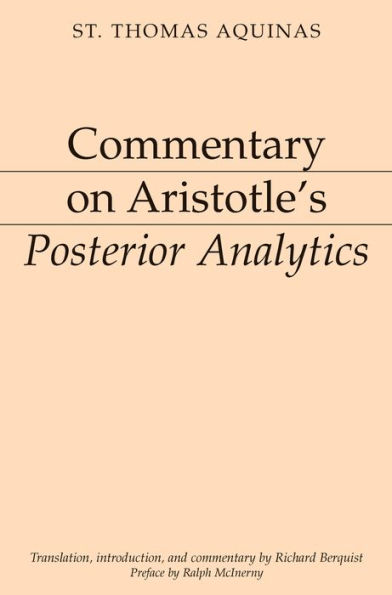
Commentary on Aristotle's Posterior Analytics
512
Commentary on Aristotle's Posterior Analytics
512Paperback
-
PICK UP IN STORECheck Availability at Nearby Stores
Available within 2 business hours
Related collections and offers
Overview
To make the work as useful as possible for contemporary readers, the translator has provided an introduction and a supplementary commentary of his own. The introduction discusses three topics of fundamental importance for the study of the Posterior Analytics today: the relationship of Aristotle's logic to symbolic logic, the scope and subject matter of logic, and the status of the syllogism as an argument form. The supplementary commentary invites the reader to further reflection on the Posterior Analytics in the light of Aquinas's interpretation. Aquinas's commentary is divided into readings or lessons (lectiones), forty-four on Book I of the Posterior Analytics and twenty on Book II. The translator's supplementary commentary follows the same arrangement. The work includes footnotes, a brief bibliography of works cited, an index, and a preface by Ralph McInerny.

Product Details
| ISBN-13: | 9781883357788 |
|---|---|
| Publisher: | St. Augustine's Press |
| Publication date: | 01/10/2008 |
| Series: | Aristotelian Commentaries Ser. |
| Pages: | 512 |
| Sales rank: | 535,492 |
| Product dimensions: | 6.00(w) x 9.00(h) x 1.50(d) |
Table of Contents
Dedication ix
Acknowledgments x
Preface Ralph McInerny xi
Introduction xiii
Note on the Translation xxix
Aquinas's Division of the Text of the Posterior Analytics xxxi
Aquinas's Commentary on the Posterior Analytics
Prooemium 1
The Need for Demonstration
Dependence of Learning on Pre-existent Knowledge 4
The Pre-existent Knowledge Required for Demonstration 6
How the Conclusion Is Foreknown 11
The Definition of the Why-Demonstration
Definition of the Why-Demonstration 15
Immediate Principles: Axioms and Suppositions 23
Principles Better Known than the Conclusion 27
Immediate Principles Not Demonstrable 30
Impossibility of Circular Demonstration 33
The Premises of the Why-Demonstration
Meaning of "Predicated of All" 39
The Modes of Per Se 42
The Commensurately Universal 47
Errors regarding the Commensurately Universal 50
Principles of Demonstration as Necessary 57
Principles of Demonstration as Per Se 64
Demonstrations Not from Extrinsic Principles 67
Demonstrations andDefinitions as Eternal 72
Demonstrations Not from Common Principles 76
Principles and Non-principles-Common and Proper Principles 80
Distinctions among Common Principles 85
Use of Common Principles 89
Questions and Arguments Proper to Each Science 94
Deceptions Proper to Each Science-Deceptions Not Found in the Sciences 97
The Premises of the Fact-Demonstration
Fact-Demonstrations from Effect to Cause 104
Fact-Demonstrations from Remote Cause 108
Fact-Demonstrations in the Subalternated Sciences 111
The Form of the Demonstration
Superiority of the First Figure-Immediate Negative Propositions 115
Falsity and Ignorance in the Demonstrative Sciences
False Syllogisms Opposed to True Immediate Negative Propositions 120
False Syllogisms Opposed to True Immediate Affirmative Propositions 126
False Syllogisms Opposed to True Mediate Propositions 131
Sense Knowledge Required for Demonstration 137
The Impossibility of Demonstrations Proceeding Infinitely
Questions about Whether Demonstrations Come to an End 140
Questions Reduced to the Question About Affirmative Demonstrations 146
Presuppositions for the Logical Proof that Demonstrations Come to an End 152
The Logical Proof that Demonstrations Come to an End 158
The Analytic Proof that Demonstrations Come to an End 165
Corollaries of the Proofs that Demonstrations Come to an End 170
Comparison of Demonstrations
Arguments for the Superiority of Particular Demonstrations 178
Universal Demonstrations Superior to Particular Demonstrations 184
Affirmative Demonstrations Superior to Negative Demonstrations 189
Negative Demonstrations Superior to Demonstrations to the Impossible 194
Comparison of Sciences to Each Other and to Other Forms of Knowledge
Certitude of Sciences-Unity and Diversity of Sciences 198
Science in Relation to Chance Events and to Sense Knowledge 206
Principles Not the Same for All Sciences 212
Science and Opinion-Quickness of Mind 220
The Middle Term: Definition and Cause
The Four Questions and Their Relation to the Middle Term 229
Opposing Arguments on the Relation of Definition and What a Thing is to Demonstration
Definition and Demonstration Not of the Same Thing 238
Impossibility of Proving What a Thing Is by Convertible Terms 244
Impossibility of Proving What a Thing Is by Divisions 249
Impossibility of Proving What a Thing Is by Supposition 254
Impossibility of Knowing What a Thing Is by Demonstration or by Definition 259
How Definition and What a Thing is Are Related to Demonstration
Showing What a Thing Is by Logical Syllogism and by Demonstration 264
Different Kinds of Definition in Relation to Demonstration 271
Demonstration and the Causes
Demonstrations through the Four Causes 277
Demonstrations When Cause and Effect Are Simultaneous or Not Simultaneous 285
Continuity in Demonstrations from Non-simultaneous Causes 291
Demonstrations for Circular Processes and for Things Which Come to Be for the Most Part 296
Searching for Definitions
Predicates Signifying What a Thing Is 300
Seeking Definitions by the Method of Division 305
Replies to Objections-Rules for the Method of Division 310
Seeking Definitions by the Method of Similarities 315
Searching for Causes
Seeking the Cause of Common Characteristics 319
How Cause and Effect Are Not Always Convertible 323
How One Effect Can Have More than One Cause 328
The First Principles
How the First Principles Come to Be Known 335
Translator's Commentary 343
References 471
Index 473
